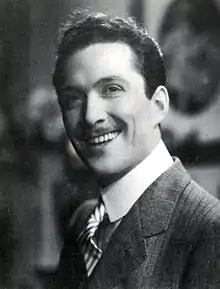Maurizio D'Ancora
Maurizio D'Ancora, born Rodolfo Gucci (1912–1983) was an Italian actor and entrepreneur, who appeared in more than forty films between 1929 until 1946. He was a member of the House of Gucci.
Maurizio D'Ancora | |
|---|---|
 | |
| Born | Rodolfo Gucci 16 July 1912 |
| Died | 15 May 1983 (aged 70) |
| Occupation | Actor, entrepreneur |
| Years active | 1929-1946 |
| Spouse(s) | Sandra Ravel |
| Children | Maurizio Gucci |
| Parent(s) |
|
| Relatives | Aldo Gucci (brother), Patrizia Reggiani (ex daughter-in-law) |
Biography
Rodolfo Gucci was born in 1912 in Florence, Italy to Aida Calvelli and Guccio Gucci.[1] He was a middle child, one of five sons and one daughter.
He was spotted by the director Alfred Lind who gave him his film debut in 1929. The same year he appeared in Mario Camerini's Rails, which launched his career.[2] While filming Together in the Dark, he met his future wife.[3] He was married in 1944 in Venice, Italy to the actress Sandra Ravel.[3][4] Their eldest son was born in 1948, Maurizio, named after his father's stage name.[3]
House of Gucci
He was one of the five sons of Guccio Gucci, founder of the fashion House of Gucci. By January 1953, D'Ancora left acting and returned to the family business after his father died.[4] In 1952, Rodolfo and his brothers Aldo, and Vasco traveled to New York City.[1] They opened the first store outside of Italy in New York City, only two weeks before their father's death.[1]
In 1967, he created the Gucci Flora scarf for Grace Kelly.[4]
After their brother Vasco Gucci died in 1974, Rodolfo and Aldo divided the business among themselves 50/50.[5] However, Aldo's sons felt that their uncle had not contributed enough to the growth of the business.[5] In an attempt to increase his profits, Aldo set up a perfume subsidiary and held 80 percent of ownership for himself and his three sons.[5] This rivalry eventually spiralled into family warfare.[5]
Death and legacy
D'Ancora died in 1983 in Milan.[6] After Rodolfo's death, Maurizio Gucci inherited his father’s majority stake in the company. In 1988, Maurizio Gucci sold almost 47.8% of Gucci to the Bahraïn-based investment fund Investcorp (owner of Tiffany & Co since 1984), and withheld the other 50%. He launched a legal battle with his uncle Aldo. In 1989, Maurizio Gucci was made chairman of the Gucci group.[7] Maurizio did not have a background in business, and the business was in a dire economic and creative straits by 1993.[7] That year Maurizio Gucci resigned, and after 66 years as a family-owned business and he sold his remaining interest to Investcorp.[7] In 1995, a year and a half after the sale of Gucci, Maurizio Gucci was gunned down by a hired hit man. His ex-wife Patrizia Reggiani was convicted of arranging the killing in 1998.[8]
Filmography
| Year | Title | Role | Notes |
|---|---|---|---|
| 1929 | Rails | Giorgio | Originally made as a silent film. |
| 1929 | Girls Do Not Joke | [9] | |
| 1931 | Figaro and His Great Day | Asdrubale Chiodini | [10] |
| 1932 | Venus | Il giovane Italo-Americano | [11] |
| 1932 | The Old Lady | Fausto | |
| 1932 | Five to Nil | ||
| 1933 | Together in the Dark | ||
| 1933 | Tourist Train | ||
| 1934 | The Canal of the Angels | ||
| 1935 | Those Two | ||
| 1935 | Golden Arrow | ||
| 1935 | Territorial Militia | ||
| 1935 | Ginevra degli Almieri | ||
| 1936 | The Ambassador | ||
| 1938 | Nonna Felicità | ||
| 1938 | The Ancestor | ||
| 1939 | No Man's Land | ||
| 1939 | The Document | L'ingegnere Pezzini detto 'Pallino' | |
| 1939 | The Night of Tricks | Filippo | [12] |
| 1940 | Don Pasquale | Ernesto | Film is loosely based on Giovanni Ruffini's libretto for Gaetano Donizetti's opera buffa Don Pasquale. |
| 1943 | Annabella's Adventure | Roberto | [13] |
| 1943 | Charley's Aunt | Guidobaldo |
References
- "Guccio Gucci". Fashion Elite. 20 September 2016. Retrieved 12 October 2020.
- Landy, Marcia (1998). The Folklore of Consensus: Theatricality in the Italian Cinema, 1930-1943. SUNY Press. p. 182. ISBN 9780791438039.
- Forden, Sara G. (8 May 2012). The House of Gucci: A Sensational Story of Murder, Madness, Glamour, and Greed. Harper Collins. p. 16. ISBN 978-0-06-222267-1.
- "Guccio Gucci". The Florentine. 17 June 2009. Retrieved 12 October 2020.
the Flora scarf, created in 1967 by his son, Rodolfo, for Grace Kelly.
- Moore, Claire (6 January 2006). "PrimeTime: Gucci, Glamour and Greed". ABC News. Retrieved 12 October 2020.
- "Rodolfo Gucci Is Dead at 71; Brother in Leather Goods Firm (Published 1983)". The New York Times. 16 May 1983. ISSN 0362-4331. Retrieved 12 October 2020.
- "Guccio Gucci". The Florentine. 17 June 2009. Retrieved 12 October 2020.
- Stanley, Alessandra (4 November 1998). "Former Wife Given 29 Years for Ordering Gucci Slaying (Published 1998)". The New York Times. ISSN 0362-4331. Retrieved 12 October 2020.
- Redi, Riccardo (1999). Cinema muto italiano (1896-1930) (in Italian). Fondazione Scuola nazionale di cinema. p. 201. ISBN 978-88-317-7330-0.
- Celli, C.; Cottino-Jones, M. (8 January 2007). A New Guide to Italian Cinema. Springer. p. 192. ISBN 978-0-230-60182-6.
- Poppi, Roberto (2002). I registi: dal 1930 ai giorni nostri. Gremese Editore. p. 56.
- Moliterno, Gino (2020). Historical Dictionary of Italian Cinema. Rowman & Littlefield Publishers, Incorporated. p. 10. ISBN 978-1-5381-1947-1.
- Moliterno, Gino (2009). The A to Z of Italian Cinema. Scarecrow Press. p. 25. ISBN 9780810870598.
Further reading
- Landy, Marcia. The Folklore of Consensus: Theatricality in the Italian Cinema, 1930-1943. SUNY Press, 1998.
